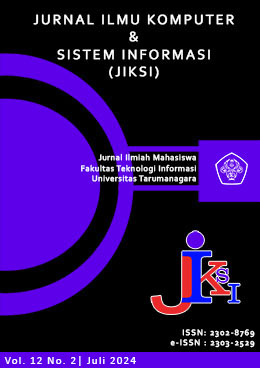PENGENALAN AKTIVITAS MANUSIA PADA SUPERMARKET MENGGUNAKAN OPENPOSE DAN CNN
Main Article Content
Abstract
Human activity recognition is a dynamic area within artificial intelligence. It involves identifying human actions during everyday tasks such as standing, sitting, and walking. One application of this technology is in supermarkets, where it can analyze consumer behavior or function as a surveillance tool to prevent theft. This particular study utilizes OpenPose and Convolutional Neural Networks (CNN) with a custom-collected dataset. The program detects human skeleton shapes from camera footage and classifies these shapes using CNN with the ResNet50 model, subsequently displaying the identified activities. The classified activities include standing, walking, picking up items, looking at items, and pushing a trolley. The testing results indicate a training accuracy of 99.76% and a validation accuracy of 96.52%, along with an accuracy score of 96.52%, a precision of 96.59%, a recall of 96.525, and an F1-score of 96.53%.
Article Details

This work is licensed under a Creative Commons Attribution-NonCommercial-ShareAlike 4.0 International License.
This work is licensed under a Jurnal Komunikasi Creative Commons Attribution-ShareAlike 4.0 International License.
References
D. Bhatt, C. Patel, H. Talsania, J. Patel, R. Vaghela, S. Pandya, K. Modi, and H. Ghayvat, “CNN Variants for Computer Vision: History, Architecture, Application, Challenges and Future Scope,” Electronics, vol. 10, no. 20, p. 2470, 2021.
R. R. Pratama, “Analisis Model Machine Learning Terhadap Pengenalan Aktifitas Manusia,” MATRIK : Jurnal Manajemen, Teknik Informatika Dan Rekayasa Komputer, vol. 19, no. 2, pp. 302-311, 2020.
D. Suryadarma, A. Poesoro, S. Budiyati, Akhamadi, and M. Rosfadhila, “Dampak Supermarket terhadap Pasar dan Pedagang Ritel Tradisional di Daerah Perkotaan di Indonesia,” SMERU, Jakarta, 2007.
A. Polacco and K. Backes, “The Amazon Go Concept: Implications, Applications, and Sustainability,” Journal of Business and Management, vol. 24, no. 1, pp. 79-92, 2018.
Z. Cao, T. Simon, S. Wei, and Y. Sheikh, “Realtime Multi-Person 2D Pose Estimation using Part Affinity Fields,” IEEE Transactions on Pattern Analysis and Machine Intelligence, vol. 43, no. 1, pp. 172-186, 2019.
S. Mroz, N. Baddour, C. J. C. McGuirk, and P. Juneau, “Comparing the Quality of Human Pose Estimation with BlazePose or OpenPose,” dalam 4th International Conference on Bio-Engineering for Smart Technologies (BioSMART), Paris, 2021.
S. Junsawang, W. Chaiyasoonthorn, and S. Chaveesuk, “Willingness to Use Self-Service Technologies Similar to Amazon Go at Supermarkets in Thailand,” dalam MSIE 2020: 2020 2nd International Conference on Management Science and Industrial Engineering, Osaka, 2020.
K. D. Runtu and Lina, “Pengenalan Aktivitas Manusia di Supermarket dengan Metode Long Short Term Memory,” Jurnal Ilmu Komputer dan Sistem Informasi, vol. 10, no. 2, 2022.
M. Arsal, B. A. Wardijono, and D. Anggraini, “ Face Recognition Untuk Akses Pegawai Bank Menggunakan Deep Learning Dengan Metode CNN,” Jurnal Nasional Teknologi dan Sistem Informasi, vol. 6, no. 1, pp. 55-63, 2020.
F. M. Qotrunnada and P. H. Utomo, “Metode Convolutional Neural Network untuk Klasifikasi Wajah Bermasker,” Prosiding Seminar Nasional Matematika, vol. 5, pp. 779-807, 2022.
S. Mukherjee, “The Annotated ResNet-50,” Toward Data Science, 18 August 2022. [Online]. Available: https://towardsdatascience.com/the-annotated-resnet-50-a6c536034758. [Diakses 11 September 2023].



